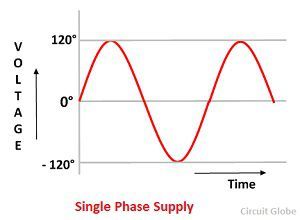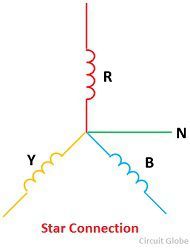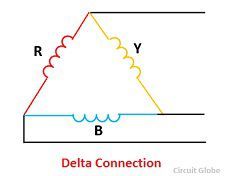The power supply system is mainly classified into two types, i.e., single phase and the three phase system. The single phase is used in a place where less power is required and for running the small loads. The three phases are used in large industries, factories and in the manufacturing unit where a large amount of power is required.
One of the major difference between the single phase and the three phase is that the single phase consists one conductor and one neutral wire whereas the three phase supply uses three conductors and one neutral wire for completing the circuit. Some other differences between them are explained below in the comparison chart.
Comparison Chart: Single Phase V/S Three Phase
Definition of Single phase
The single phase requires two wires for completing the circuit, i.e., the conductor and the neutral. The conductor carries the current and the neutral is the return path of the current. The single phase supplies the voltage up to 230 volts. It is mostly used for running the small appliances like a fan, cooler, grinder, heater, etc.
Definition of Three Phase
The three phase system consist four wires, three conductors and one neutral. The conductors are out of phase and space 120º apart from each other. The three phase system is also used as a single phase system. For the low load, one phase and neutral can be taken from the three phase supply.
The three phase supply is continuous and never completely drops to zero. In three phase system power can be drawn either in a star or delta configuration. The star connection is used for long distance transmission because it has neutral for the fault current.
The delta connection consists three phase wires and no neutral.
Key Differences Between Single Phase and Three Phase
- In single phase supply, the power flows through one conductor whereas the three phase supply consists three conductors for power supply.
- The single phase supply requires two wires (one phase and one neutral) for completing the circuit. The three phase requires three phase wires and one neutral wire for completing the circuit.
- The single phase supplies the voltage up to 230V whereas the three phase supply carries the voltage up to 415V.
- The maximum power is transferred through three phases as compared to single phase supply.
- The single phase has two wire which makes the network simple whereas the three phase network is complicated as it consists four wires.
- The single phase system has only one phase wire, and if the fault occurs on the network, then the power supply completely fails. But in three phase system the network has three phases, and if the fault occurs on any one of the phases, the other two will continuously supply the power.
- The efficiency of the single phase supply is less as compared to three phase supply. Because the three phase supply requires less conductor as compared to single phase supply for the equivalent circuit.
- The single phase supply requires more maintenance and become costly as compared to three phase supply.
- The single phase supply is mostly used in the house and for running the small loads. The three phase supply is used in large industries and for running the heavy loads.
The star connection of the three phase allows the use of two different voltages (i.e., the 230 volts and the 415 volts). The 230V is supplied by using the one phase and one neutral wire, and the three phase is supply between any two phases.









Nice Article
Excellent article and it is very helpfull for me.
Very helpful for final round of studies in exams.
that is amazing
thanks………
Thank you so much for this basic information…it will be very helpful for everyone..
Nice points sir covered all factors
Very useful information.
helpful
thank you soo much for the article…. best website
Nice , really helpful
THANK YOU❤
Great content
Was Looking for basics,yes I got it
This is actually what I’ve been searching for,simple explanation…😊
This was helpful, great explanation.
Thanks for your information and it’s helpful for learners